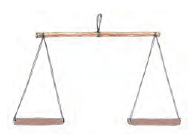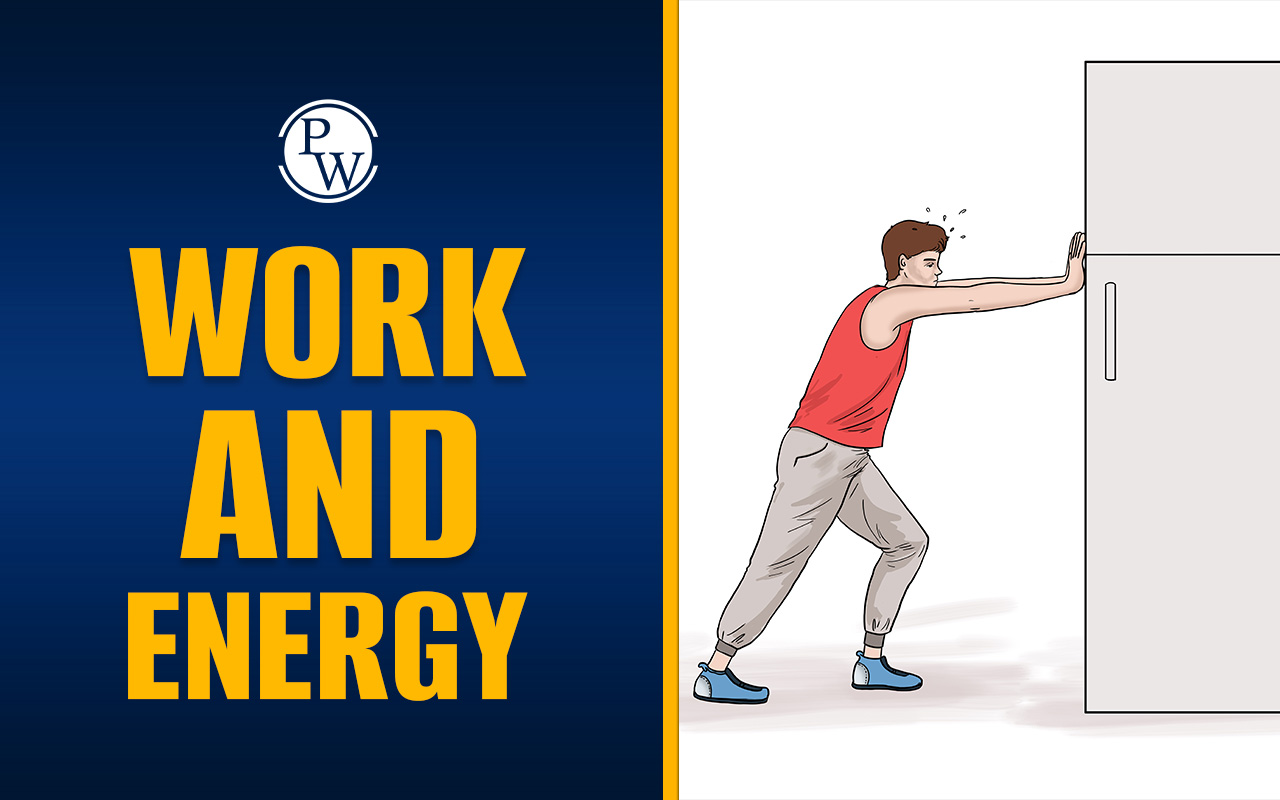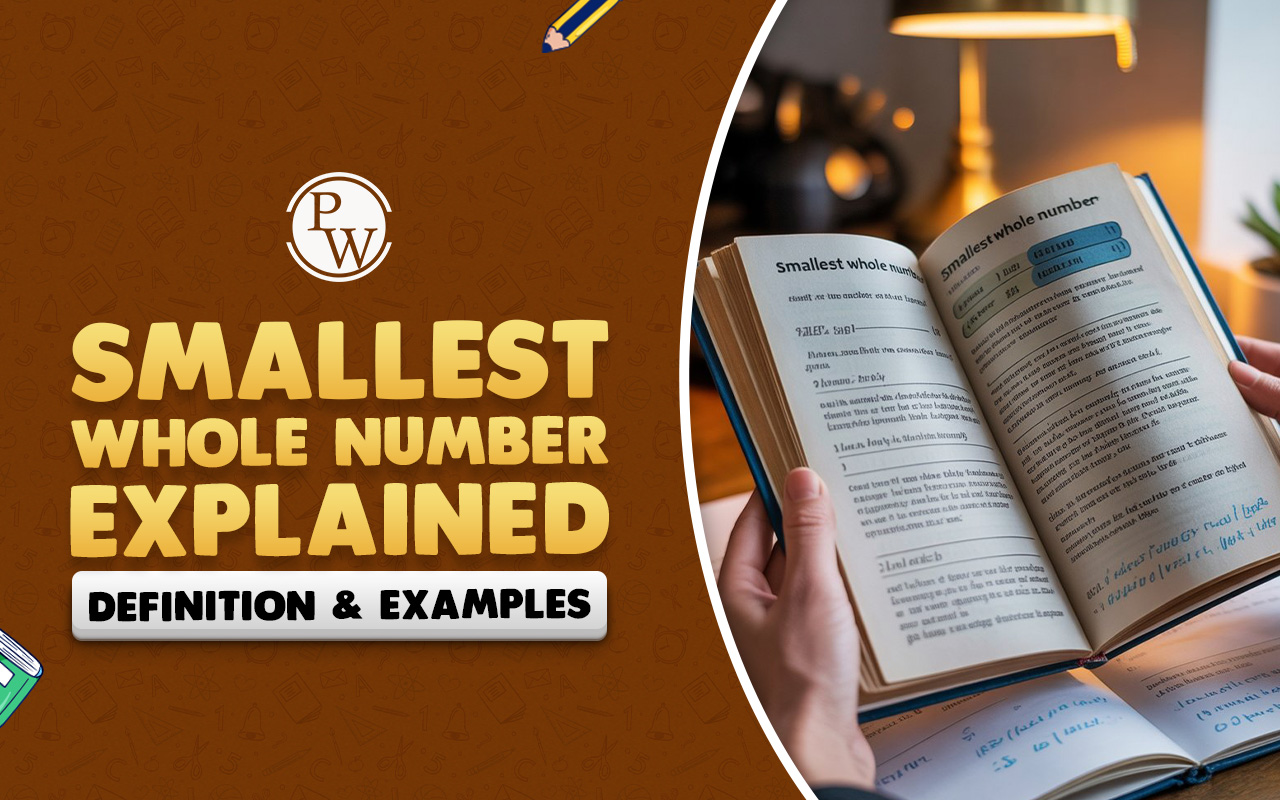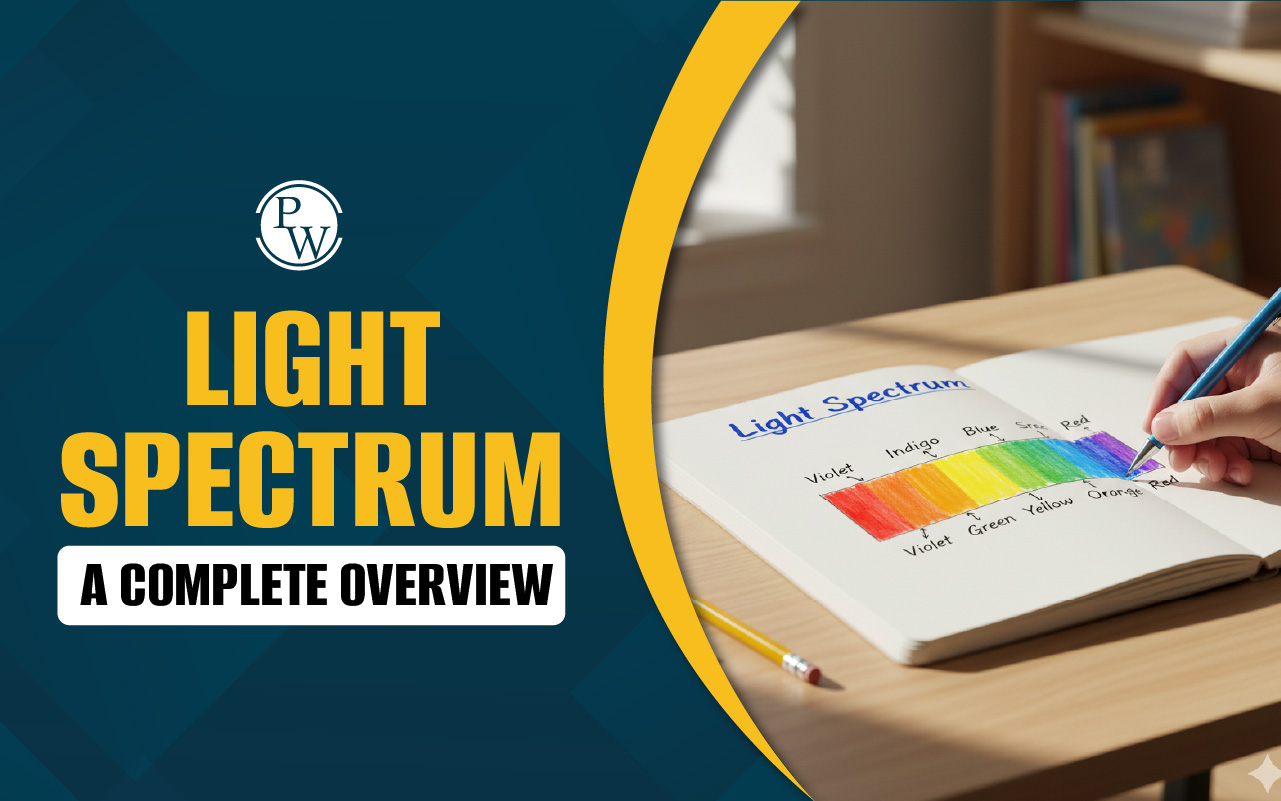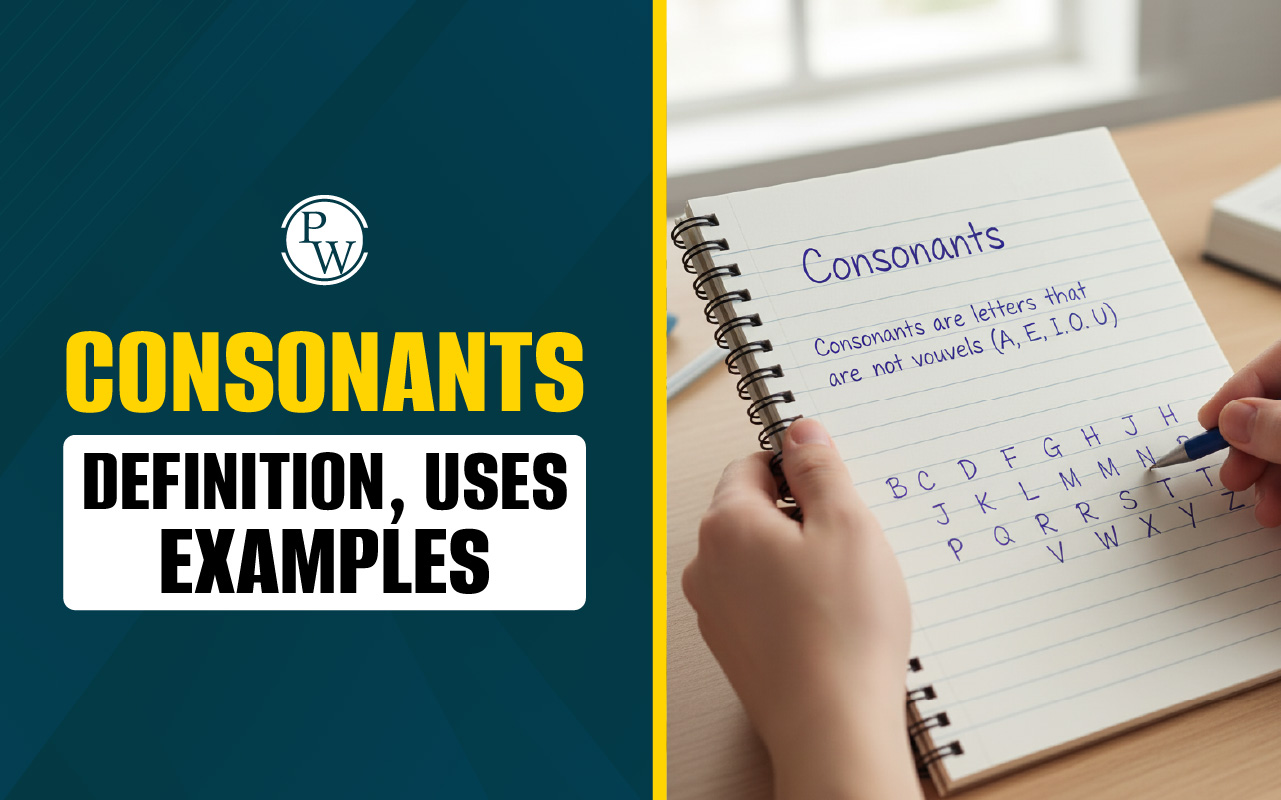
NCERT Solutions for Class 4 Maths Chapter 12: NCERT Solutions for Class 4 Maths Chapter 12 How Heavy? How Light?“ Students can find solutions here to solve several types of questions asked on the exam. By referring to these NCERT Solutions students can get a better understanding of the concept of weights. The chapter uses practical examples to help students learn the difference between heavy and light items.
It emphasises the usage of standard units like kilograms and grams. Students can understand how to estimate, compare, and measure weights in their daily lives with the help of these exercises and activities included in NCERT Solutions for Class 4 Maths Chapter 12.
NCERT Solutions for Class 4 Maths
NCERT Solutions for Class 4 Maths Chapter 12 How Heavy? How Light? Overview
Chapter 12 of the NCERT Class 4 Maths textbook, "How Heavy? How Light?", is intended to introduce students to the fundamental ideas of measuring, with a focus on weight. Students will learn how to distinguish between heavy and light objects in this chapter, as well as the significance of measuring weight using appropriate units.
Basic unit conversions, including kilograms to grams and vice versa, are covered in this chapter. The NCERT solutions for this chapter include practice problems that improve students' understanding and use of weight-related calculations, together with comprehensive explanations and detailed instructions to help them understand these concepts.
NCERT Solutions for Class 4 Maths Chapter 12 How Heavy? How Light? PDF
The NCERT Solutions for Class 4 Maths Chapter 12 How Heavy? How Light? are provided in PDF format through the following link for ease of use and reference.
Ensuring that students are able to understand the concepts and practise at their own speed, this PDF includes detailed explanations and step-by-step solutions to all the problems in this chapter. For younger learners, the exercises are intended to reinforce important concepts, making the learning process engaging and easily accessible.
NCERT Solutions for Class 4 Maths Chapter 12 PDF
NCERT Solutions for Class 4 Maths Chapter 12 How Heavy? How Light?
Here we have provided NCERT Solutions for Class 4 Maths Chapter 12: How Heavy? How Light? -
NCERT Solutions for Class 4 Maths Chapter 12 How Heavy? How Light? Page No: 134
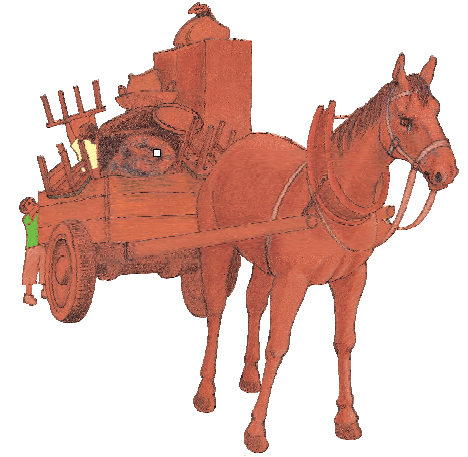
Jaiju and Mannu were shifting the house. They loaded all their things on a horse-cart. There were many things, like – a water tank, five sacks of wheat, three tables, an almirah, four chairs, two mattresses, three sacks of rice, a bamboo ladder, pots and pans.
Father gave them some idea of the weight of each thing.
| Things loaded | Weight |
| A sack of wheat | 100 kg |
| A sack of rice | 35 kg |
| Water tank | 50 kg |
| Almirah | 70 kg |
| A table | 10 kg |
| A chair | 5 kg |
| A mattress | 20 kg |
| Bamboo ladder | 10 kg |
| Pots and pans | 10 kg |
Question: 1
Calculate the overall weight they had loaded on the cart.
Answer: Weights of all the things are given below-
| Things loaded | Weight | Number of Items | Overall Weights Per Items |
| A sack of wheat | 100 kg | 5 | 5 × 100 = 500 kg |
| A sack of rice | 35 kg | 3 | 3 × 35 = 105 kg |
| Water tank | 50 kg | 1 | 1 × 50 = 50 kg |
| Almirah | 70 kg | 1 | 1 × 70 = 70 kg |
| A table | 10 kg | 3 | 3 × 10 = 30 kg |
| A chair | 5 kg | 4 | 4 × 5 = 20 kg |
| A mattress | 20 kg | 2 | 2 × 20 = 40 kg |
| Bamboo ladder | 10 kg | 1 | 1 × 10 = 10 kg |
| Pots and pans | 10 kg | 1 | 10 kg |
| Overall Weights of all the things loaded on the cart | 835 kg | ||
Therefore, the overall weight they had loaded on the cart was 835 kg.
Question: 2
Which things should be removed so that the weight of the load is not more than 700 kg?
Answer: The weight of the load that should be removed to get the weight equal to 700 kg = 835 – 700 = 135 kg
From the table,
The weight of 3 sacks of rice = 105 kg
The weight of 3 tables = 30 kg
Overall weight of both of these two things = 105 + 30 = 135 kg
Therefore, to get the weight equal to 700 kg, they should eliminate 3 sacks of rice and 3 tables.
Question: 3
Now, you also make your own balance. Write down how you made it. Also, draw a picture of your balance in the box below.
Answer: Procedures for creating a balance:
- A symmetrical rod is used.
- Now, pick two wires that are identical to each other and tie them to both ends of the rod.
- Using two identical pans, hang the plate from the rod.
- Now, put the hook in the centre of the symmetrical rod.
NCERT Books for Class 4 Maths 2024-25
NCERT Solutions for Class 4 Maths Chapter 12 How Heavy? How Light? Page No. 135
Question: 4

Answer: We know that the pencil is lighter than the geometry box. Therefore, the pan with the geometry box will go down.
What is Heavier?
Question: 5
Make pairs of different things and use the balance to decide which is heavier. First, guess which thing will take the pan down and then check your balance.
Answer: Following are the pairs of different things:
(a) Scale and geometry box
A geometry box is heavier than a scale. So, the pan that has the geometry box will go down.
(b) Glass and fork
Glass is heavier than a fork. Hence, the pan that has the glass will go down.
(c) Toothbrush and toothpaste
Toothpaste is heavier than a toothbrush. Therefore, the pan that has the toothpaste will go down.
(d) Napkin and trouser
A trouser is heavier than a napkin. Hence, the pan that has the trouser will go down.
What is the heaviest?
Question: 6
(a) Make groups of three things. For example – eraser, ball and paper. Use the balance to arrange them in order of weight – the lightest, the one with in-between weight, and the heaviest. Complete the table with at least five examples.
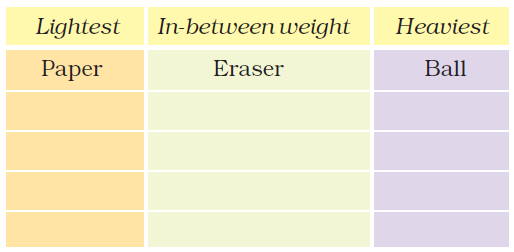
Answer:
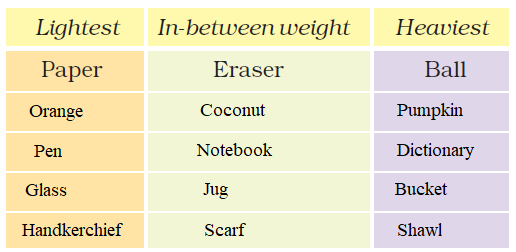
(b) Can you find your own weight using this balance?
Answer: No, we cannot find our own weight.
Related Links-
NCERT Solutions for Class 4 Maths Chapter 12 How Heavy? How Light? Page No.136
Making Weights
Question: 7
Get a new cake of soap. The packet will have the weight written on it. You can use this soap to make your own different weights.
The soap weighs _________ grams (g)
Answer: The soap weighs 100 grams.
Question: 8
Take a small plastic packet. Put it in one pan of the balance. Put the soap in the other pan. Slowly add sand to the packet till the pans are balanced.
Close the packet with a rubber band or string. Now stick a strip of paper; how many grams will both these weigh?
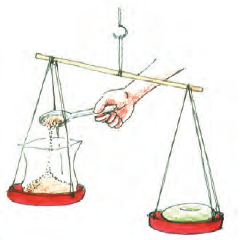
Answer: It is written 100 gm on the packet.
Question: 9
If you put the soap and the weight you just made together in a pan, how many grams will both these weigh?
Answer: Both these weigh = 100 + 100 = 200 gm
NCERT Solutions for Class 4 Maths Chapter 12 How Heavy? How Light? Page No: 137
Question: 10
(a) Which pan of the balance will go down? Show by drawing an arrow.
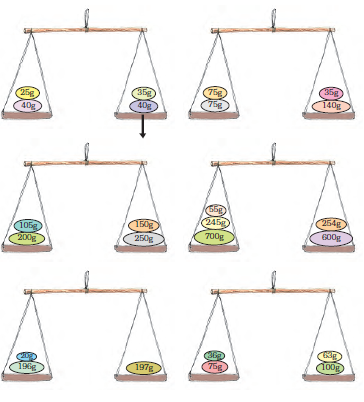
Answer: Do it yourself.
(b) Is the weight on any of the pans equal to 1 kilogram? Mark it.
Answer: The left pan of the fourth diagram weighs 1000 gm. The pan includes weights measuring 55 g, 245 g and 700 g, i.e.,
55 + 245 + 700 = 1000 g
= 1 kg
Therefore, the left pan of the fourth diagram is equal to 1 kilogram.
(c) How many grams are there in 1 kg?
Answer: We know
1 kg = 1000 g
Hence, there are 1000 grams in 1 kilogram.
NCERT Solutions for Class 4 Maths Chapter 12 How Heavy? How Light? Page No. 138
Question: 11
Name 5 things that we usually buy.
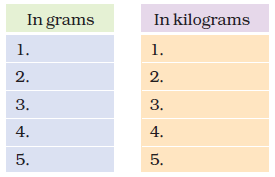
Answer: In grams we buy things which are needed in very less quantity whereas in kilograms we buy things which are used in large quantities.
| In grams | In kilograms |
| Turmeric powder | Tomatoes |
| Mustard seeds | Sugar |
| Chilli powder | Wheat |
| Cardamom | Apples |
| Cloves | Rice |
Question: 12
Which is Heavier?

Answer: Both have equal weight.
NCERT Solutions for Class 4 Maths Chapter 12: How Heavy? How Light? Page No: 139
Dinesan Went Shopping
Dinesan went to a shop and bought some things.
His younger brother cut the end of the bill where the weights were written.
Question: 13
Guess and write the weight of each thing he bought – in g or kg.
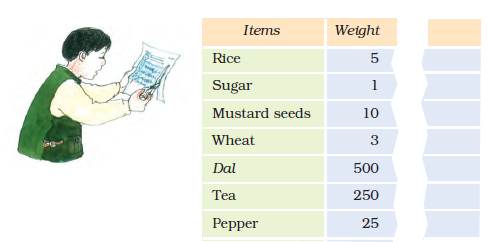
Answer: The weights of the given items are as follows:
| Items | Weight |
| Rice | 5 kg |
| Sugar | 1 kg |
| Mustard seeds | 10 g |
| Wheat | 3 kg |
| Dal | 500 g |
| Tea | 250 g |
| Pepper | 25 g |
Question: 14
(a)
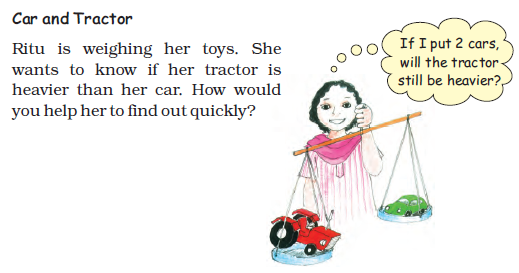
Answer: This can be done by keeping the tractor and car in each of the pan of the balance separately. This tells us that among the two toys, the one that falls is the heavier one.
(b) Guess which is the heaviest: a real car, a bus or a tractor?
Answer: A bus is the heaviest.
(c) Which is the heaviest thing you have seen?
Answer: The heaviest thing I have seen is a rail engine.
NCERT Solutions for Class 4 Maths Chapter 12 How Heavy? How Light? Page No.140
Elephant’s Weight
Question: 15
Now imagine what happened next and complete the story. Discuss with your friends how Vaidika’s daughter found the weight of the elephant.
Answer: First, Vaidika's daughter measured how deep the boat sank in the river. Next, she requested that they load the elephant into the boat. The boat now sank farther, and she observed the boat's new water level. When the elephant got on the boat, she asked the king to place the gold there until the water level reached the newly elevated mark. With no other choice, the king was forced to pay Vaidika the gold equivalent to the elephant's weight.
NCERT Solutions for Class 4 Maths Chapter 12: How Heavy? How Light? Page No: 143
How Much the Chair Weighs
Question: 16
Anamika wants to weigh this chair using the weighing machine.
Can you suggest a way to do this?
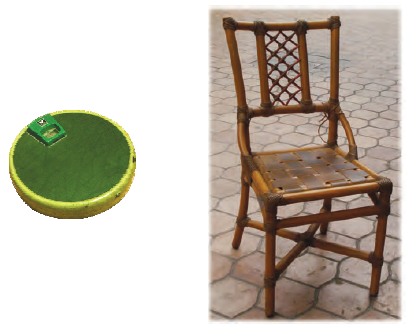
Answer: First, Anamika should keep a flat wooden slab on the weighing machine, on which the chair can be placed easily and record its weight. Then she should put the chair on the slab kept on the weighing machine. The difference in the weight of the chair with the wooden slab and the weight of the wooden slab will give the weight of the chair.
NCERT Solutions for Class 4 Maths Chapter 12 How Heavy? How Light? Page No. 143
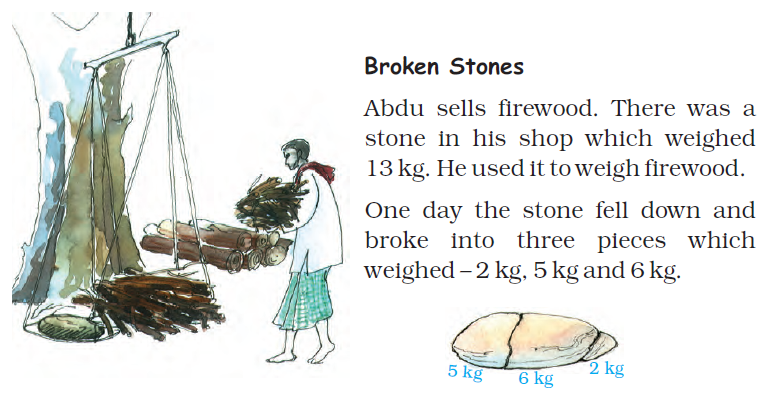
Question: 17
Now you show how Abdu will use these stone pieces to weigh.
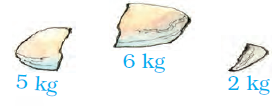
(a) 4 kg of firewood
Answer:
He can weigh 4 kg of wood by keeping a 6 kg broken stone on the left pan and a 2 kg broken stone on the right pan filled with firewood. Their difference, i.e. 6 – 2 = 4 kg, will indicate the weight of firewood.
(b) 3 kg of firewood
Answer: He can weigh 3 kg of firewood by keeping the broken stone of 5 kg on the left pan and the broken stone of 2 kg on the right pan with firewood. The difference in weight, i.e., 5 – 2 = 3 kg, will indicate the weight of firewood.
(c) 7 kg of firewood
Answer: He can weigh 7 kg of firewood by keeping the broken stone of 5 kg and 2 kg on the right pan and firewood on the left pan.
NCERT Solutions for Class 4 Maths Chapter 12: How Heavy? How Light? Page No. 145
Post Office
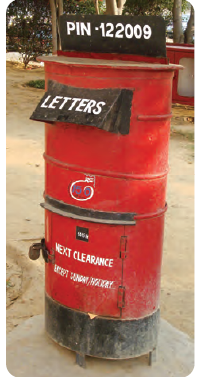
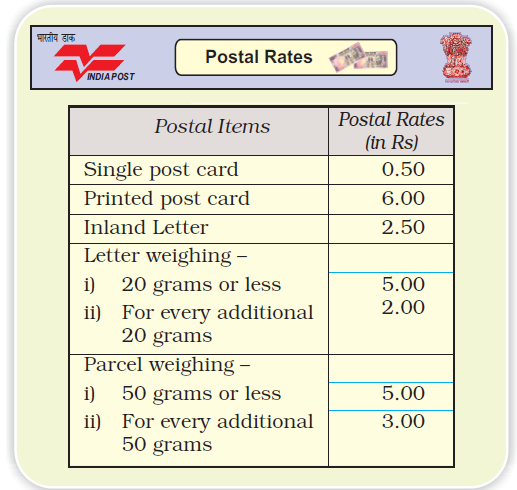
Question: 18
Have you ever been to a post office?
Answer: Yes.
Question: 19
What different things do people go there for?
Answer: People go to the post office for the following reasons which is given below:
(i) To post the letters
(ii) To buy an envelope, stamps, postcards, etc.
(iii) For banking
(iv) To send money orders
Question: 20
How much does a postcard cost?
Answer: The cost of the postcard is Rs 0.50.
Question: 21
How much does an inland letter cost?
Answer: The cost of the inland letter is Rs 2.50.
Look at the postal rates given in the chart.
Question: 22
How much will you have to pay for stamps on a letter weighing 50 grams?
Answer: The stamps are required upto 20 grams = Rs 5.00
For next 20 grams = Rs 2.00
For next 10 grams = Rs 2.00
Total cost of stamps = Rs 5.00 + Rs 2.00 + Rs 2.00
= Rs 9.00
Therefore, I have to pay Rs 9.00 for stamps on a letter weighing 50 grams.
Question: 23
Akash wants to send a parcel of the Math Magic textbook to his friend Rani in Chennai. The book weighs 200 g. See the chart to find the cost of posting the book.
Answer: Akash wants to parcel the book to his friend Rani. Below are the costs he has to pay for the parcel:
The weight of the book = 200 grams
The cost of a parcel upto 50 grams = Rs 5.00
The cost of additional 150 grams = Rs 3.00 × 3
= Rs 9.00
Total cost = Rs 5.00 + Rs 9.00
= Rs 14
Question: 24
Read the weight shown in the picture. Find out the cost of sending a parcel of that weight.
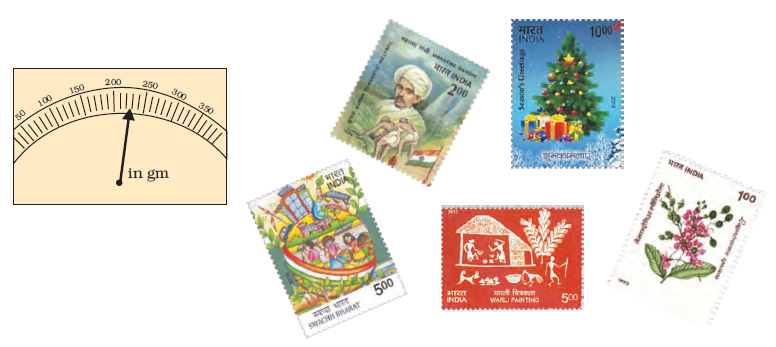
Answer: The weight of the parcel on the weighing machine = 225 gram
Postal charges for 50 grams = Rs 5.00
For additional 50 grams = Rs 3.00
For next 50 grams = Rs 3.00
For next 50 grams = Rs 3.00
For next 50 grams = Rs 3.00
Total postal charges = Rs 5.00 + Rs 3.00 + Rs 3.00 + Rs 3.00 + Rs 3.00 = Rs 17.00
NCERT Solutions for Class 4 Maths Chapter 12: How Heavy? How Light? Page No. 146
How Many Stamps?
Question: 25
Rahul needs stamps of Rupees 25 for his parcel. He went to the post office. Only stamps of Rs 1, Rs 2, Rs 5 and Rs 10 were there at that time. Using those stamps, in how many different ways can he make Rs 25?
Answer: By using available stamps, he can make Rs 25 in the following ways:
(a) Rs 1 × Rs 25 = Rs 25
(b) Rs 2 × Rs 12 + Rs 1 = Rs 24 + Rs 1 = Rs 25
(c) Rs 5 × Rs 5 = Rs 25
(d) Rs 10 × Rs 2 + Rs 5 = Rs 20 + Rs 5 = Rs 25
(e) Rs 10 + Rs 5 × Rs 3 = Rs 10 + Rs 15 = Rs 25
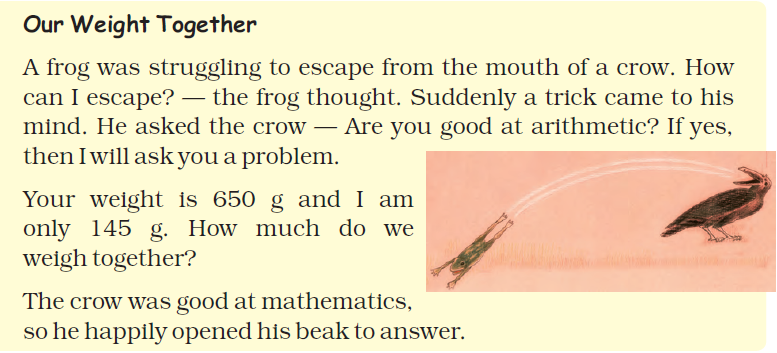
Question: 26
What happened after that? So what was the answer the crow wanted to give?
Answer: The frog jumped out of the crow's mouth as it opened its mouth to the query. Crow responded, saying, "Together, we weigh 795 grams."
NCERT Solutions for Class 4 Maths Chapter 12: How Heavy? How Light? Page No. 147
Am I Fit or Fat?
The chart shows the height and weight of children between 6 and 10 years old.
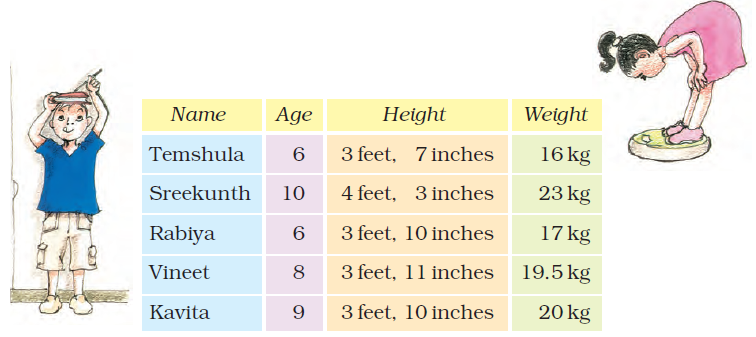
Question: 27
Now, you also fill the table by finding out the age, height and weight of any five friends.
Answer: Some of my friends’ name, age, height and weight are as follows:
| Name | Age | Height | Weight |
| Kavita | 7 | 4 feet 4 inches | 24 kg |
| Shreya | 6 | 4 feet 2 inches | 20 kg |
| Anjali | 10 | 5 feet 2 inches | 30 kg |
| Nikita | 9 | 5 feet 1 inch | 25 kg |
| Rashmi | 8 | 4 feet 9 inches | 22 kg |
NCERT Solutions for Class 4 Maths Chapter 12: How Heavy? How Light? Page No. 148
How Many Oranges?
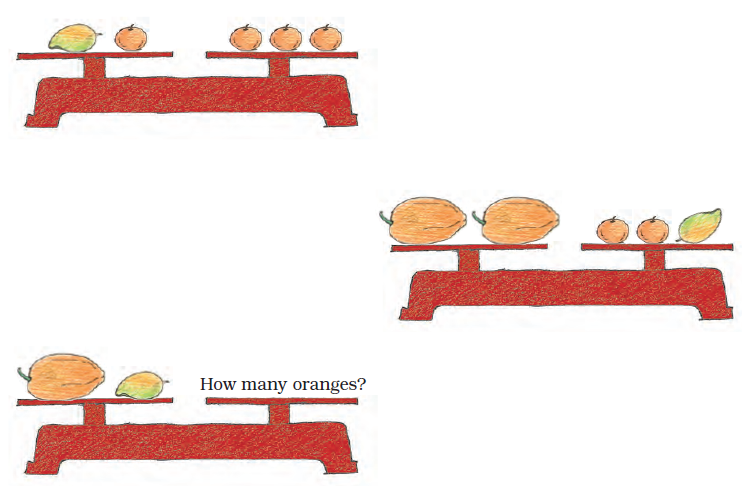
Question: 28
All oranges have equal weight. The two papayas have the same weight. The weights in the first and second balances are equal.
How many oranges balance the weight in the third?
Answer: In the first balance,
1 Mango + 1 Orange = 3 Oranges
1 Mango = 3 Oranges – 1 Orange
1 Mango = 2 Oranges
Hence, 1 Mango = 2 Oranges
In the second balance,
2 Papaya = 2 Oranges + 1 Mango
2 Papaya = 2 Oranges + 2 Oranges [1 Mango = 2 Oranges]
2 Papaya = 4 Oranges
Hence, 1 Papaya = 2 Oranges
In the third balance,
1 Papaya + 1 Mango = 2 Oranges + 2 Oranges [1 Papaya = 2 Oranges and 1 Mango = 2 Oranges]
1 Papaya + 1 Mango = 4 Oranges
Therefore, in the third balance, 4 Oranges will balance 1 Papaya and 1 Mango together.
Find That Marble
Question: 29
There are 3 marbles of the same size, but one marble is slightly heavier or lighter than the other two. Can you find which is that marble and if it is heavier or lighter? You can use a balance only two times.
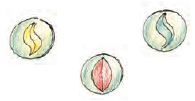
Answer: Let us take the three marbles as M1, M2 and M3 in which one of them is lighter or heavier than the other two.
Put marbles M1 and M2 in different pans.
First case: If both are equal, then M3 is lighter or heavier than these marbles.
Second case: Put M1 and M3 in different pans
(a) If they are equal, then M2 is lighter or heavier.
(b) M1 < M3 then M2 = M3 and M1 will be lighter than M1 and M3.
Benefits of NCERT Solutions for Class 4 Maths Chapter 12 How Heavy? How Light?
Following are the Benefits of NCERT Solutions for Class 4 Maths Chapter 12 How Heavy? How Light?-
- Clear Explanations: The solutions provide students a clear understanding of how to approach and solve various problem types by providing step-by-step explanations.
- Complete Coverage: All of the exercises in the chapter are covered in detail by the solutions, which guarantees that students will have practice with every kind of question that might appear on their tests.
- Reinforcement of Concepts: Students may strengthen their understanding of weight-related concepts, such as measuring weights of different things and analysing their weights, by working through these solutions.
- Homework Help: By using these resources, students may do their homework and make sure they are moving in the proper direction.
- Exam Preparation: By practicing with these solutions, students get more familiar with the format and types of questions asked on the examinations.
- Error Correction: To assist them learn from their mistakes, students can compare their answers with the solutions to find and fix any mistakes they make.
- Improving Confidence: By observing the proper procedures and solutions, students who have access to complete solutions realise a growth in self-assurance in their ability to solve problems.
NCERT Solutions for Class 4 Maths 12 How Heavy? How Light? FAQs
In Chapter 12 of the NCERT Solutions for Class 4 Maths, what did Jaiju and Mannu put into the horse-cart to shift their house?
Considering the topic covered in Chapter 12 of NCERT Solutions for Class 4 Maths, what are the materials required to create your own balance?
How can NCERT Solutions assist with this chapter?
How can I practise solving this chapter's problems?
What is Weights and their measurement unit?

